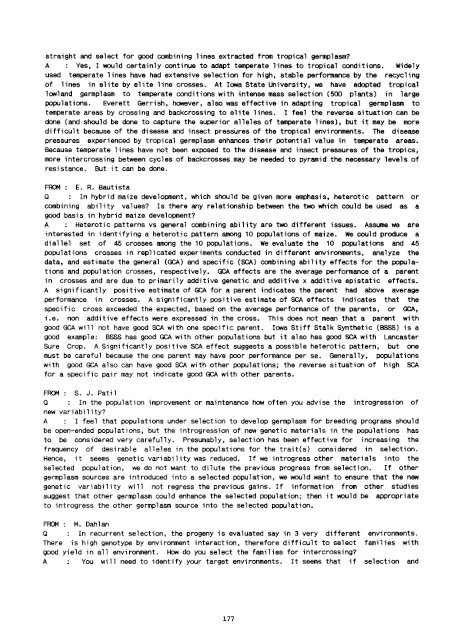Proceedings of the Fifth Asian Regional Maize Workshop - Search ...
Proceedings of the Fifth Asian Regional Maize Workshop - Search ...
Proceedings of the Fifth Asian Regional Maize Workshop - Search ...
You also want an ePaper? Increase the reach of your titles
YUMPU automatically turns print PDFs into web optimized ePapers that Google loves.
straight and select for good combining lines extracted from tropical germplasm?<br />
A Yes, I would certainly continue to adapt temperate lines to tropical conditions. Widely<br />
used temperate lines have had extensive selection for high, stable performance by <strong>the</strong> recycling<br />
<strong>of</strong> lines in elite by elite line crosses. At Iowa State University, we have adopted tropical<br />
lowland germplasm to temperate conditions with intense mass selection (500 plants) in large<br />
populations. Everett Gerrish, however, also was effective in adapting tropical germplasm to<br />
temperate areas by crossing and backcrossing to elite lines. I feel <strong>the</strong> reverse situation can be<br />
done (and should be done to capture <strong>the</strong> superior alleles <strong>of</strong> temperate lines), but it may be more<br />
difficult because <strong>of</strong> <strong>the</strong> disease and insect pressures <strong>of</strong> <strong>the</strong> tropical environments. The disease<br />
pressures experienced by tropical germplasm enhances <strong>the</strong>ir potential value in temperate areas.<br />
Because temperate lines have not been exposed to <strong>the</strong> disease and insect pressures <strong>of</strong> <strong>the</strong> tropics,<br />
more intercrossing between cycles <strong>of</strong> backcrosses may be needed to pyramid <strong>the</strong> necessary levels <strong>of</strong><br />
resistance. But it can be done.<br />
FROM: E. R. Bautista<br />
Q In hybrid maize development, which should be given more emphasis, heterotic pattern or<br />
combining ability values? Is <strong>the</strong>re any relationship between <strong>the</strong> two which could be used as a<br />
good basis in hybrid maize development?<br />
A Heterotic patterns vs general combining ability are two different issues. Assume we are<br />
interested in identifying a heterotic pattern among 10 populations <strong>of</strong> maize. We could produce a<br />
diallel set <strong>of</strong> 45 crosses among <strong>the</strong> 10 POPUlations. We evaluate <strong>the</strong> 10 populations and 45<br />
populations crosses in replicated experiments conducted in different environments, analyze <strong>the</strong><br />
data, and estimate <strong>the</strong> general (GCA) and specific (SCA) combining ability effects for <strong>the</strong> populations<br />
and population crosses, respectively. GCA effects are <strong>the</strong> average performance <strong>of</strong> a parent<br />
in crosses and are due to primarily additive genetic and additive x additive epistatic effects.<br />
A significantly positive estimate <strong>of</strong> GCA for a parent indicates <strong>the</strong> parent had above average<br />
performance in crosses. A significantly positive estimate <strong>of</strong> SCA effects indicates that <strong>the</strong><br />
specific cross exceeded <strong>the</strong> expected, based on <strong>the</strong> average performance <strong>of</strong> <strong>the</strong> parents, or GCA,<br />
i.e. non additive effects were expressed in <strong>the</strong> cross. This does not mean that a parent with<br />
good GCA will not have good SCA with one specific parent. Iowa Stiff Stalk Syn<strong>the</strong>tic (BSSS) is a<br />
good example: BSSS has good GCA with o<strong>the</strong>r populations but it also has good SCA with Lancaster<br />
Sure Crop. A Significantly positive SCA effect suggests a possible heterotic pattern, but one<br />
must be careful because <strong>the</strong> one parent may have poor performance per se. Generally, populations<br />
with good GCA also can have good SCA with o<strong>the</strong>r populations; <strong>the</strong> reverse situation <strong>of</strong> high SCA<br />
for a specific pair may not indicate good GCA with o<strong>the</strong>r parents.<br />
FROM: S. J. Patil<br />
Q In <strong>the</strong> population improvement or maintenance how <strong>of</strong>ten you advise <strong>the</strong> introgression <strong>of</strong><br />
new variability?<br />
A I feel that populations under selection to develop germplasm for breeding programs should<br />
be open-ended populations, but <strong>the</strong> introgression <strong>of</strong> new genetic materials in <strong>the</strong> populations has<br />
to be considered very carefully. Presumably, selection has been effective for increasing <strong>the</strong><br />
frequency <strong>of</strong> desirable alleles in <strong>the</strong> populations for <strong>the</strong> trait(s) considered in selection.<br />
Hence, it seems genetic variability was reduced. If we introgress o<strong>the</strong>r materials into <strong>the</strong><br />
selected population, we do not want to dilute <strong>the</strong> previous progress from selection. If o<strong>the</strong>r<br />
germplasm sources are introduced into a selected population, we would want to ensure that <strong>the</strong> new<br />
genetic variability will not regress <strong>the</strong> previous gains. If information from o<strong>the</strong>r studies<br />
suggest that o<strong>the</strong>r germplasm could enhance <strong>the</strong>' selected population; <strong>the</strong>n it would be appropriate<br />
to introgress <strong>the</strong> o<strong>the</strong>r germplasm source into <strong>the</strong> selected population.<br />
FROM: M. Dahlan<br />
Q In recurrent selection, <strong>the</strong> progeny is evaluated say in 3 very different environments.<br />
There is high genotype by environment interaction, <strong>the</strong>refore difficult to select families with<br />
good yield in all environment. How do you select <strong>the</strong> families for intercrossing?<br />
A You will need to identify your target environments. It seems that if selection and<br />
177

















